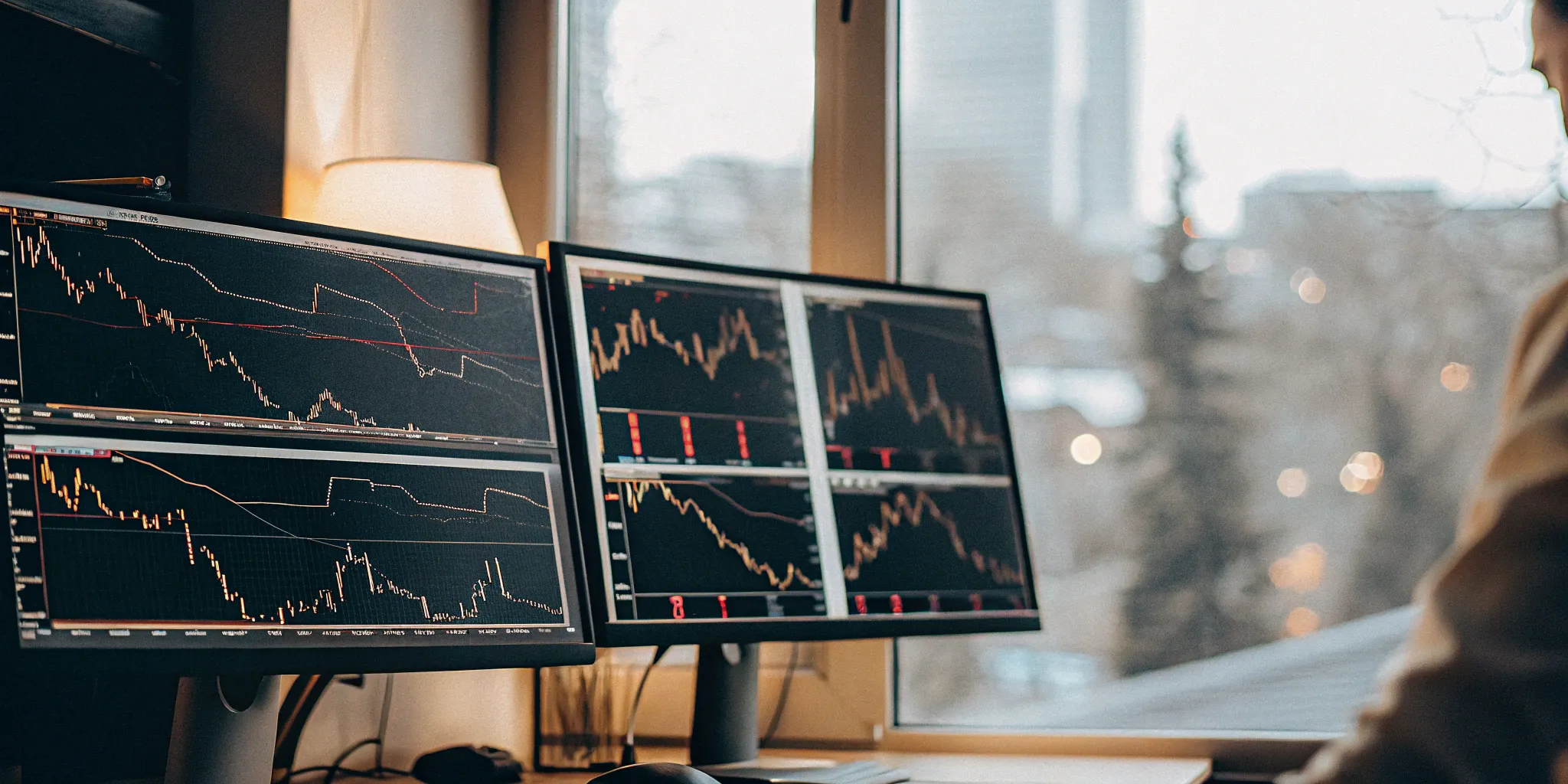Tired of spending countless hours monitoring markets and executing trades? Wish you had more time to focus on refining your strategies and exploring new opportunities? Algorithmic trading might be the answer. This powerful tool automates the trading process, freeing you from time-consuming tasks and potentially improving your returns. Join us as we explore how algo trading saves time, allowing you to manage multiple strategies, automate market analysis, and streamline risk management, all while minimizing human error. We’ll also discuss the technical requirements for effective algo trading and address common misconceptions, providing a clear and actionable guide to leveraging this technology.
Key Takeaways
- Automated trading saves time and reduces errors. Algorithms execute trades quickly and efficiently, minimizing the impact of emotions and human error on your investment decisions.
- Algorithms streamline analysis and risk management. Rapid data processing identifies market trends and automates risk mitigation, freeing you to focus on broader strategy.
- AI and cloud computing enhance algo trading. These technologies offer faster execution, more complex analysis, and greater accessibility for traders of all levels.
What is Algorithmic Trading and How Does it Save Time?
Algorithmic trading, also known as algo trading, uses computer programs to execute trades based on pre-defined rules. This automation allows for incredibly fast and frequent trades, far beyond what any human trader could manage. Think of it as putting your trading strategy on autopilot, letting the algorithm seize market opportunities in real time. This significantly reduces the hours you’d typically spend manually monitoring and executing trades.
This speed advantage is crucial in today’s fast-moving financial markets, where even fractions of a second can impact trade outcomes. Algo trading capitalizes on this speed, executing trades with precision and efficiency. Beyond speed, algo trading minimizes human error and emotional decision-making—two factors that often lead to costly mistakes. By relying on pre-programmed logic, you remove impulsive reactions from the equation, leading to more disciplined trading. Learn more about algo trading and its benefits.
Another major time-saver is the ability to analyze vast amounts of market data simultaneously. Algorithms can identify patterns and opportunities that might be missed through manual analysis, processing information quickly and accurately to give you a significant edge. This automated market analysis frees up your time to focus on refining your strategies and other important aspects of your business. For a deeper dive into automated strategies, check out this comprehensive guide. At FN Capital, our proprietary FAST AI algorithm embodies these advantages, executing thousands of EUR/USD trades each month with precision and speed.
Execute Trades Faster with Algorithmic Speed
Speed is paramount in financial markets. Milliseconds can mean the difference between capturing a profitable opportunity and missing out. Algorithmic trading gives you a significant edge by executing trades at speeds impossible for humans. Imagine trying to manually execute hundreds, or even thousands, of trades per minute. Computer programs excel at this, processing vast amounts of data and reacting to market changes almost instantaneously. This speed advantage allows algorithmic systems like our FAST AI to capitalize on fleeting market inefficiencies and execute complex strategies with precision. Algorithmic trading uses computer programs to execute trades based on pre-set rules.
This speed isn’t just about rapid-fire trading; it’s about intelligent execution. Our algorithms analyze real-time market data, identify optimal entry and exit points, and execute trades with minimal slippage. Slippage is the difference between the expected price of a trade and the price at which it’s executed. In fast-moving markets, slippage can significantly impact your returns. By automating the execution process, algorithmic trading minimizes slippage and ensures you get the best possible price. This level of precision is especially crucial in high-frequency trading, where even microseconds matter. While our FAST AI system isn’t strictly high-frequency trading (HFT), we leverage similar principles to optimize execution speed and efficiency. This translates to more profitable trades and a stronger bottom line.
Eliminate Human Error and Emotional Decisions
Even the most disciplined traders make mistakes. Markets are volatile, and emotions like fear and greed cloud judgment. Algorithmic trading helps eliminate these emotional pitfalls by automating the trading process. Computers don’t experience the emotional rollercoaster of winning or losing, leading to more objective, data-driven decisions. This systematic approach, based on pre-defined rules and parameters, minimizes impulsive trades driven by fear or FOMO (fear of missing out).
Think of your algorithm as a tireless, emotionless trading machine, executing your strategy flawlessly regardless of market conditions. It removes human error, ensuring trades are placed with precision and speed. This is especially crucial in fast-moving markets where split-second decisions matter. By taking the human element out of the process, algorithmic trading allows for faster execution and reduces the risk of costly mistakes caused by emotional reactions. This doesn’t guarantee profits—no trading strategy does—but it does mean you’re making decisions based on data and logic, not gut feelings. Misconceptions about algorithmic trading abound, but removing emotional bias is a clear advantage. With FN Capital’s FAST AI, you can experience the benefits of emotionless, data-driven trading, maximizing your potential for consistent returns.
Time-Saving Algo Trading Strategies
One of the biggest advantages of algo trading is its ability to execute various strategies, saving you time and potentially boosting your returns. Let’s explore some popular approaches:
Trend Following and Momentum Trading
Trend following is a classic strategy where algorithms identify and capitalize on established market trends. These strategies are designed to buy assets showing upward momentum and sell those declining. Because trends can last for extended periods, these algorithms aren’t constantly making trades, freeing up your time. Momentum trading, a similar approach, focuses on short-term price swings, aiming to profit from rapid market movements. Algo trading systems excel at identifying and reacting to these fleeting opportunities, often too quick for human traders to catch. As these strategies involve identifying and exploiting tiny price differences that humans might miss, they are well-suited for algo trading.
Arbitrage and Statistical Arbitrage
Arbitrage involves exploiting price discrepancies for the same asset across different markets. For example, a currency might trade at slightly different prices on two separate exchanges. An arbitrage algorithm can automatically detect and profit from this difference by buying low on one exchange and simultaneously selling high on the other. Statistical arbitrage is a more complex version, using statistical models to identify temporary mispricings within the same market. These strategies rely on the speed and precision of algorithms to execute trades before the inefficiencies disappear. The integration of artificial intelligence (AI) into algorithmic trading has revolutionized market efficiency, enabling traders to execute strategies with unprecedented speed and precision.
Mean Reversion and Pairs Trading
Mean reversion strategies operate on the principle that prices tend to fluctuate around an average value. When an asset’s price deviates significantly from this average, the algorithm bets that it will eventually revert back. This involves buying undervalued assets and selling overvalued ones. Pairs trading is a specific type of mean reversion that focuses on the relationship between two correlated assets. The algorithm identifies when the prices of these assets diverge from their historical correlation and places trades anticipating their eventual convergence. These automated strategies save time and reduce the emotional burden of trading by systematically executing buy and sell orders based on statistical analysis rather than gut feelings. This approach can be automated to save time and reduce the emotional burden of trading.
Automate Market Analysis and Research
Market analysis and research can be incredibly time-consuming. Sifting through charts, news feeds, and economic calendars takes focus and energy—and even then, you might miss key insights. Algorithmic trading systems automate this process, freeing you from hours of manual research. Algorithms can process vast quantities of market data far faster than any human, identifying emerging trends and patterns you might otherwise overlook. This speed advantage translates into quicker identification of opportunities and more efficient trading decisions. For example, algorithms can analyze multiple market factors simultaneously, considering everything from price and volume to news sentiment and economic indicators.
They can execute complex calculations and statistical analyses in milliseconds, providing you with real-time insights and actionable information. This rapid data processing significantly reduces the time you’d typically spend on market research, allowing you to focus on strategy development and refinement. Instead of getting bogged down in the details, you can concentrate on the bigger picture. Algo trading empowers you to make informed decisions quickly and efficiently, capitalizing on market opportunities as they arise. By automating the analysis of market conditions, these systems execute trades based on sophisticated strategies that consider a range of indicators, ultimately enhancing the efficiency of your entire trading process. You’re essentially leveraging the power of computing to gain a significant edge in the markets.
Streamline Risk Management and Portfolio Optimization
Risk management is crucial for any trader. Manually monitoring market fluctuations and adjusting your portfolio can be time-consuming and prone to errors. Algorithmic trading systems offer a way to automate and streamline this process, freeing up your time and potentially improving your results. One of the key advantages of algorithmic trading is its ability to automate risk management based on predefined parameters. You can set specific rules for your trades, such as stop-loss orders and position sizing limits, and the algorithm will automatically execute them. This helps maintain consistent risk levels without constant oversight.
This automated approach also minimizes the impact of human emotions on trading decisions. Fear and greed can often lead to impulsive choices that deviate from your overall strategy. By relying on a pre-programmed algorithm, you remove emotional biases, ensuring that your trades are executed according to your plan, even in volatile market conditions. Algorithms can analyze vast amounts of data in real-time, enabling dynamic portfolio adjustments that align with current market conditions and your risk tolerance. This responsiveness helps you capitalize on opportunities and mitigate potential losses more effectively than manual adjustments.
Furthermore, algorithmic trading systems provide data-driven insights that enhance your decision-making process. By analyzing historical data and identifying patterns, algorithms can offer valuable information about market trends and potential risks. This allows you to develop more informed risk management strategies and optimize your portfolio accordingly. Automating the trading process also minimizes human error, a critical factor in risk management and portfolio optimization. Even small mistakes in manual trading can lead to significant losses. Automated trading reduces this risk by ensuring precision and consistency in trade execution.
Finally, algorithmic trading allows for real-time risk assessment and management. The system can continuously monitor market conditions and adjust your portfolio accordingly. This enables you to respond swiftly to changes and protect your investments. By automating these crucial aspects of trading, you can focus on developing your overall strategy and achieving your long-term financial goals.
Manage Multiple Strategies Simultaneously
One of the biggest advantages of algorithmic trading is managing multiple strategies at once. Think of it as having a team of expert traders working 24/7, each focused on a specific approach. Algorithms execute trades based on pre-defined conditions and parameters, freeing you from constant monitoring. This allows you to diversify your investments and capitalize on different market opportunities concurrently. The Ambilio website offers a helpful case study illustrating the benefits of this approach.
Manually monitoring several trading strategies across different markets is nearly impossible. Algorithmic trading platforms let you set up multiple algorithms, each targeting specific market conditions or asset classes. This simultaneous execution saves you time and increases profit potential by responding to various market movements. You’re essentially casting a wider net to catch more profitable trades.
This automation also means you can monitor and execute trades across different markets and instruments without manual intervention, dramatically improving efficiency, especially for active traders. Algorithmic trading platforms help you respond to market changes and execute trades at the best possible times, avoiding the delays of manual trading. It’s like having a super-efficient trading assistant working around the clock.
Technical Requirements for Effective Algo Trading
Getting started with algo trading requires a blend of technical skills and the right tools. While FN Capital handles these complexities for you, understanding the foundational elements helps you appreciate the power of automated trading.
Essential Programming Languages
Building your own algorithms requires coding skills. Languages like Python are popular for their versatility and extensive libraries for data analysis and financial modeling. Other languages like C++ offer speed advantages for high-frequency trading. If coding isn’t your forte, platforms like QuantConnect offer a codeless environment for building strategies.
Market Data Access and Analysis Tools
Real-time market data is the lifeblood of any algo trading system. Having access to accurate and up-to-the-minute price feeds, trading volume, and economic news is crucial. Specialized data providers offer APIs and other tools to integrate this information directly into your trading platform. Analytical tools, including charting software and statistical packages, help you identify patterns and develop effective trading strategies.
Trading Platforms and APIs
Choosing the right trading platform is essential for executing your algorithms seamlessly. Platforms like TradeStation, Interactive Brokers, and QuantConnect cater to different levels of experience and offer various features. Look for platforms with robust APIs (Application Programming Interfaces) that allow you to connect your algorithms directly to the market, automating order placement and execution. Consider factors like commission fees, available markets, and the platform’s overall reliability when making your decision.
Common Algo Trading Misconceptions
Let’s clear up some common misunderstandings about algorithmic trading. It’s easy to get caught up in the hype, but a realistic view will help you make informed decisions.
One of the biggest misconceptions is the idea of guaranteed profits. Like any investment strategy, algo trading has inherent risks. While a well-designed algorithm can identify opportunities and execute trades efficiently, market volatility and unforeseen events can still impact returns. Algorithmic trading isn’t a magic bullet; it’s a tool that requires careful planning and management. Don’t get caught up in the myth of risk-free returns. All trading involves risk. Exaggerated profit projections on social media should be approached with healthy skepticism.
Another misconception is that algo trading is overly complex and only for institutions. Many platforms and tools make algo trading accessible to individual investors. AI-driven trading might seem intimidating, but with some research and the right resources, anyone can get started. Individual traders shouldn’t feel excluded by the myth that it’s only for institutions. Plenty of systems cater to all types of investors.
By understanding the realities of algo trading, you can effectively use it as a tool to enhance your trading strategies and reach your financial goals.
The Future of Algo Trading: AI and Cloud Computing
The world of algorithmic trading is constantly evolving, with artificial intelligence (AI) and cloud computing playing increasingly important roles. These technologies offer exciting possibilities for traders looking to refine their strategies and achieve better results. AI, in particular, has become a game-changer, enabling faster trade execution and more complex analysis. As AI algorithms become more sophisticated, they can analyze vast datasets in real-time, identifying subtle patterns and trends that humans might miss. This allows for more informed decisions and the potential for increased profitability.
Cloud computing is another key driver of innovation in algo trading. By providing on-demand access to powerful computing resources and vast amounts of data, the cloud empowers traders to develop and deploy sophisticated algorithms without the need for expensive infrastructure. This scalability is crucial in today’s fast-paced markets, allowing traders to adapt quickly to changing conditions and optimize their strategies in real time. The cloud also facilitates collaboration and information sharing, creating a more dynamic and interconnected trading ecosystem. The combination of cloud computing and AI is not just improving existing trading strategies; it’s opening up entirely new possibilities.
Imagine algorithms that can learn and adapt to market conditions autonomously, constantly refining their approach to maximize returns. As these technologies mature, we can expect to see even more innovative applications in the world of algorithmic trading. This will lead to greater efficiency, more sophisticated strategies, and potentially higher profits for those who embrace these advancements. For a deeper dive into the software and tools driving this evolution, explore some of the best algorithmic trading software options.
Related Articles
- Algorithmic Trading Guide: Benefits, Strategies, Tools
- Automated Trading Returns: Strategies for Success
- How Algorithmic Trading Works: An Overview – FN Capital
- Algorithmic Trading Software 2025 Guide: Key Insights
- Benefits of Automated Trading: A Practical Guide – FN Capital – Like a Bank, But Smarter
Frequently Asked Questions

Is algorithmic trading only for professional traders?
Not at all! While institutional investors have used algorithmic trading for a while, the tools and platforms available today make it accessible to individual investors too. At FN Capital, we’ve designed our platform to be user-friendly, regardless of your trading experience. Our FAST AI algorithm handles the complexities, allowing you to benefit from automated trading without needing advanced technical skills.
What are the main advantages of using algorithmic trading?
Algorithmic trading offers several key benefits. It executes trades much faster than a human could, minimizing slippage and maximizing efficiency. It removes emotional decision-making, leading to more disciplined trading. It automates market analysis, saving you valuable time and potentially uncovering hidden opportunities. Finally, it streamlines risk management by adhering to pre-defined rules and parameters.
What is FAST AI and how does it work?
FAST AI is FN Capital’s proprietary algorithmic trading system. It’s designed to identify and capitalize on low-risk, high-probability trading opportunities in the EUR/USD currency pair. The algorithm analyzes real-time market data, executes trades automatically, and dynamically adjusts risk parameters using our DART (Dynamic Algorithmic Risk Tool). This automated approach removes emotional bias and maximizes efficiency.
What are the technical requirements for using FN Capital’s platform?
You don’t need any specialized software or coding skills to use our platform. We handle all the technical complexities behind the scenes. All you need is a computer or mobile device with internet access to monitor your account and track your trading performance. Our user-friendly interface makes it easy to get started and manage your investments.
What if I’m not satisfied with the performance of FAST AI?
We offer a 100-day money-back guarantee. If you’re not happy with the results you see within the first 100 days, you can request a full refund. This risk-free trial period allows you to experience the benefits of FAST AI with complete peace of mind.





